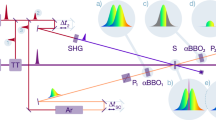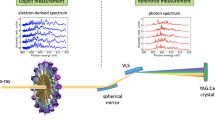Abstract
The ability to fully characterize ultrashort, ultra-intense X-ray pulses at free-electron lasers (FELs) will be crucial in experiments ranging from single-molecule imaging to extreme-timescale X-ray science. This issue is especially important at current-generation FELs, which are primarily based on self-amplified spontaneous emission and radiate with parameters that fluctuate strongly from pulse to pulse. Using single-cycle terahertz pulses from an optical laser, we have extended the streaking techniques of attosecond metrology to measure the temporal profile of individual FEL pulses with 5 fs full-width at half-maximum accuracy, as well as their arrival on a time base synchronized to the external laser to within 6 fs r.m.s. Optical laser-driven terahertz streaking can be utilized at any X-ray photon energy and is non-invasive, allowing it to be incorporated into any pump–probe experiment, eventually characterizing pulses before and after interaction with most sample environments.
This is a preview of subscription content, access via your institution
Access options
Subscribe to this journal
Receive 12 print issues and online access
$209.00 per year
only $17.42 per issue
Buy this article
- Purchase on Springer Link
- Instant access to full article PDF
Prices may be subject to local taxes which are calculated during checkout





Similar content being viewed by others
References
Ackermann, W. et al. Operation of a free-electron laser from the extreme ultraviolet to the water window. Nature Photon. 1, 336–342 (2007).
Emma, P. et al. First lasing and operation of an angstrom-wavelength free-electron laser. Nature Photon. 4, 641–647 (2010).
Pile, D. X-rays first light from SACLA. Nature Photon. 5, 456–457 (2011).
Ishikawa, T. et al. A compact X-ray free-electron laser emitting in the sub-ångström region. Nature Photon. 6, 540–544 (2012).
Ding, Y. et al. Measurements and simulations of ultralow emittance and ultrashort electron beams in the Linac Coherent Light Source. Phys. Rev. Lett. 102, 254801 (2009).
Emma, P. et al. Femtosecond to subfemtosecond X-ray pulses from a self-amplified spontaneous-emission-based free-electron laser. Phys. Rev. Lett. 92, 074801 (2004).
Meyer, M. et al. Angle-resolved electron spectroscopy of laser-assisted Auger decay induced by a few-femtosecond X-ray pulse. Phys. Rev. Lett. 108, 063007 (2012).
Först, M. et al. Driving magnetic order in a manganite by ultrafast lattice excitation. Phys. Rev. B 84, 241104 (2011).
Rohringer, N. et al. Atomic inner-shell X-ray laser at 1.46 nanometres pumped by an X-ray free-electron laser. Nature 481, 488–491 (2012).
Vinko, S. M. et al. Creation and diagnosis of a solid-density plasma with an X-ray free-electron laser. Nature 482, 59–U75 (2012).
Young, L. et al. Femtosecond electronic response of atoms to ultra-intense X-rays. Nature 466, 56–U66 (2010).
Neutze, R., Wouts, R., van der Spoel, D., Weckert, E. & Hajdu, J. Potential for biomolecular imaging with femtosecond X-ray pulses. Nature 406, 752–757 (2000).
Siebert, M. M. et al. Single mimivirus particles intercepted and imaged with an X-ray laser. Nature 470, 78–U86 (2011).
Barty, A. et al. Self-terminating diffraction gates femtosecond X-ray nanocrystallography measurements. Nature Photon. 6, 35–40 (2012).
Saldin, E. L., Schneidmiller, E. A. & Yurkov, M. V. Statistical and coherence properties of radiation from x-ray free-electron laser. New J. Phys. 12, 035010 (2010).
Cavalieri, A. L. et al. Clocking femtosecond X-rays. Phys. Rev. Lett. 94, 114801 (2005).
Azima, A. et al. Time resolved pump–probe experiments beyond the jitter limitations at FLASH. Appl. Phys. Lett. 94, 144102 (2009).
Tavella, F., Stojanovic, N., Geloni, G. & Gensch, M. Few femtosecond timing at fourth-generation X-ray light sources. Nature Photon. 5, 162–165 (2011).
Radcliffe, P. et al. Single-shot characterization of independent femtosecond extreme ultraviolet free electron and infrared laser pulses. Appl. Phys. Lett. 90, 131108 (2007).
Gahl, C. et al. A femtosecond X-ray/optical cross-correlator. Nature Photon. 2, 165–169 (2008).
Maltezopoulos, T. et al. Single-shot timing measurement of extreme-ultraviolet free-electron laser pulses. New J. Phys. 10, 033026 (2008).
Bionta, M. R. et al. Spectral encoding of X-ray/optical relative delay. Opt. Express 19, 21855–21865 (2011).
Schorb, S. et al. X-ray-optical cross-correlator for gas-phase experiments at the Linac Coherent Light Source free-electron laser. Appl. Phys. Lett. 100, 121107 (2012).
Beye, M. et al. X-ray pulse preserving single-shot optical cross-correlation method for improved experimental temporal resolution. Appl. Phys. Lett. 100, 121108 (2012).
Amann, J. et al. Demonstration of self-seeding in a hard-X-ray free-electron laser. Nature Photon. 6, 693–698 (2012).
Christov, I., Murnane, M. M. & Kapteyn, H. C. High-harmonic generation of attosecond pulses in the ‘single-cycle’ regime. Phys. Rev. Lett. 78, 1251–1254 (1997).
Kienberger, R. et al. Atomic transient recorder. Nature 427, 817–821 (2004).
Goulielmakis, E. et al. Single-cycle nonlinear optics. Science 320, 1614–1617 (2008).
Schultze, M. et al. Delay in photoemission. Science 328, 1658–1662 (2010).
Itatani, J. et al. Attosecond streak camera. Phys. Rev. Lett. 88, 173903 (2002).
Baltuska, A. et al. Attosecond control of electronic processes by intense light fields. Nature 421, 611–615 (2003).
Gagnon, J., Goulielmakis, E. & Yakovlev, V. S. The accurate FROG characterization of attosecond pulses from streaking measurements. Appl. Phys. B 92, 25–32 (2008).
Frühling, U. et al. Single-shot terahertz-field-driven X-ray streak camera. Nature Photon. 3, 523–528 (2009).
Eriksson, F. et al. Atomic scale interface engineering by modulated ion-assisted deposition applied to soft X-ray multilayer optics. Appl. Opt. 47, 4197–4204 (2008).
Planken, P., Nienhuys, H., Bakker, H. & Wenckebach, T. Measurement and calculation of the orientation dependence of terahertz pulse detection in ZnTe. J. Opt. Soc. Am. B 18, 313–317 (2001).
Yeh, K. L., Hoffmann, M. C., Hebling, J. & Nelson, K. A. Generation of 10 µJ ultrashort terahertz pulses by optical rectification. Appl. Phys. Lett. 90, 171121 (2007).
Tiedtke, K. et al. Gas-detectors for X-ray lasers. J. Appl. Phys. 103, 094511 (2008).
Nicolosi, P. et al. Grazing-incidence spectrometer for the monitoring of the VUV FEL beam at DESY. J. Electron Spectrosc. Rel. Phenom. 144, 1055–1058 (2005).
Spence, D. E., Sleat, W. E., Evans, J. M., Sibbett, W. & Kafka J. D. Time synchronization measurements btween 2 self-modelocked Ti:sapphire lasers. Opt. Commun. 101, 286–296 (1993).
Ma, L-S. et al. Sub-10 femtosecond active synchronization of two passively mode-locked Ti:sapphire oscillators. Phys. Rev. A 64, 021802(R) (2001).
Bonifacio, R., Pellegrini C. & Narducci, L. Collective instabilities and high-gain regime in a free electron laser. Opt. Commun. 50, 373–378 (1984).
Kim, K-J. An analysis of self-amplified spontaneous emission. Nucl. Instrum. Methods A 250, 396–403 (1986).
Hoffmann, M. C. & Fulop, J. A. Intense ultrashort terahertz pulses: generation and applications. J. Phys. D 44, 083001 (2011).
Duesterer, S. et al. Femtosecond X-ray pulse length characterization at the Linac Coherent Light Source free-electron laser. New J. Phys. 13, 093024 (2011).
Hauri, C. P., Ruchert, C., Vicario, C. & Ardana, F. Strong-field single-cycle THz pulses generated in an organic crystal. Appl. Phys. Lett. 99, 161116 (2011).
Hirori, H., Doi, A., Blanchard, F. & Tanaka, K. Single-cycle terahertz pulses with amplitudes exceeding 1 MV/cm generated by optical rectification in LiNbO(3). Appl. Phys. Lett. 99, 091106 (2011).
Acknowledgements
The authors owe special thanks to the scientific and technical staff at FLASH at the Deutsches Elektronen-Synchrotron (DESY), Hamburg, for operation and delivery of the SASE–FEL beam. Portions of this work were funded by the Max Planck Society through institutional support for the Max Planck Research Department for Structural Dynamics at the University of Hamburg, by the Munich Centre for Advanced Photonics, and by the Science Foundation Ireland PI (grant no. 07/IN.1/I1771), IRCSET and the EXTATIC EMJD. N.M.K. is grateful to European XFEL GmbH and to the Donostia International Physics Center (DIPC) for hospitality and financial support. He also acknowledges financial support from the programme ‘Physics with Accelerators and Reactors in West Europe’ of the Russian Ministry of Education and Science.
Author information
Authors and Affiliations
Contributions
A.L.C., M.C.H. and H.S. conceived the project. I.G. and M.C.H. designed and executed the experiments. C.B., A.L.C., J.T.C, S.D., T.J.K., A.R.M., M.M., T.M., P.R., H.S. and Th.T. assisted in experimental realization. C.B., A.L.C., I.G., M.C.H., A.K.K., N.M.K., A.R.M., T.M., M.M., H.S. and Th.T. analysed and/or interpreted the data. A.L.C., S.D. and M.M. contributed materials to the experiments. A.L.C., J.T.C., I.G., M.C.H., M.M., H.S. and Th.T. wrote the paper.
Corresponding author
Ethics declarations
Competing interests
The authors declare no competing financial interests.
Supplementary information
Supplementary information
Supplementary information (PDF 901 kb)
Rights and permissions
About this article
Cite this article
Grguraš, I., Maier, A., Behrens, C. et al. Ultrafast X-ray pulse characterization at free-electron lasers. Nature Photon 6, 852–857 (2012). https://doi.org/10.1038/nphoton.2012.276
Received:
Accepted:
Published:
Issue Date:
DOI: https://doi.org/10.1038/nphoton.2012.276
This article is cited by
-
Unsupervised real-world knowledge extraction via disentangled variational autoencoders for photon diagnostics
Scientific Reports (2022)
-
A self-referenced in-situ arrival time monitor for X-ray free-electron lasers
Scientific Reports (2021)
-
Clocking Auger electrons
Nature Physics (2021)
-
Water-Window X-Ray Pulses from a Laser-Plasma Driven Undulator
Scientific Reports (2020)
-
Spectral phase control of interfering chirped pulses for high-energy narrowband terahertz generation
Nature Communications (2019)



